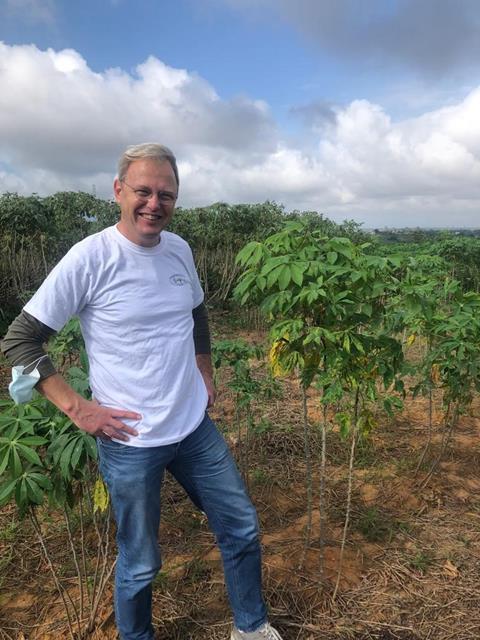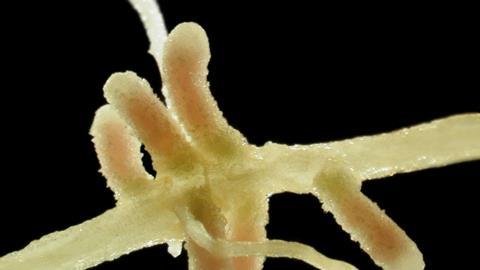Rene Geurts, a molecular biologist in Wageningen, is working on a more than 100-year-old question: can we get plants other than clover to coexist with bacteria that fix nitrogen from the air? This would be a solution to the global fertiliser problem.
Like all other life on Earth, plants need nitrogen, including for their proteins and DNA regulation. Although our atmosphere is 78% nitrogen gas (N2), this form of nitrogen is not useful to most organisms. It takes a lot of energy to break the triple bond between two nitrogen atoms. Most plants therefore use ammonia or nitrate to meet their nitrogen needs.
’I want to put genetic constructs into cassava’
There are three ways to convert atmospheric nitrogen into a form useful to organisms. The first is run-off from thunderstorms: nitrate sometimes ends up in raindrops. Second, there are certain bacteria, known as nitrogen fixers, that have the enzyme complex nitrogenase, which can convert N2 into ammonia. These Rhizobium bacteria live in symbiosis with leguminous plants, especially clover, in special organs called nodules (see photo above). They make nitrogen available to the plant. Finally, there is the Haber-Bosch process, developed by chemists. This laid the foundations for the production of fertiliser - a product on which half the world’s population now depends.
Modern, intensive agriculture is impossible without fertiliser. But fertiliser use is very inefficient. Plants absorb only 20-50% of the nitrogen compounds applied. The rest is washed into surface waters. This leads to algae blooms and subsequent oxygen-depleted dead zones. Bacteria can also convert the added ammonium and nitrate into the potent greenhouse gas N2O. Then there is the issue of fairness: not all farmers have access to fertiliser.
New organs
But what if you could make other plants produce root nodules containing dust-fixing bacteria? Then they would need no fertiliser, or at least a lot less. Rene Geurts, Associate Professor of Molecular Biology at Wageningen University & Research, thinks this is possible. Or at least that there is enough information to make a serious attempt.
To infect leguminous plants such as clover, Rhizobium bacteria produce certain sugars: lipochito-oligosaccharides. These act as nod factors. These are substances that promote nodule formation. The root cells of leguminous plants have a receptor that recognises the Nod factors and then initiates nodule development. This starts with the division of cells in the cortex - the outer layer - of the root. ‘These dividing cells,’ says Geurts, ‘have a unique property: they can be infected by Rhizobium.’ Once inside, Rhizobium differentiates. It begins to focus on a single task: nitrogen fixation. In exchange for the nitrogen it fixes, the plant provides the bacteria with nutrients.
’100 million years ago, plants with root nodules diverged from the rest.’
In addition, root nodules have another important function: the fixation of oxygen. Nitrogenase, the bacterial enzyme complex that converts N2 to ammonia, only works in a low-oxygen environment. To make it, the plant produces leghemoglobin, the plant form of haemoglobin. The haem group of leghemoglobin binds oxygen and regulates the oxygen tension in the root nodules.

Three key genes
More than two hundred plant genes are involved in this process: far too many to transfer to other plants. By comparing nitrogen-fixing plants with non-nitrogen-fixing plants, and legumes with non-legumes, Geurts reduced the number of essential genes to three. Many of the other two hundred genes were found to be present in other plants.
One of the three remaining genes encodes a Nod factor receptor, NFR5, which is needed to recognise nitrogen-fixing bacteria. The second gene encodes a transcription factor, NIN, the master regulator of root nodule development and bacterial uptake. The third gene, RPG, is involved in the entry of the bacteria.
With these three genes, other plants should, in theory, also be able to form root nodules. But in practice it is not that simple, says Geurts: ‘It is 100 million years since plants with root nodules split off from the rest. All sorts of evolutionary changes have taken place since then.’ To increase the chances of success, Geurts turned to a plant that is evolutionarily close to legumes: cassava, a shrub known for its edible root tuber.
’There is a difference between researching a new mechanism and engineering.’
I want to introduce genetic constructs into cassava that are most likely to have generic functionality in nodulating plants,” says Geurts. Initially, his group is focusing on the Nod factor receptor and transcription factor. We are looking at whether you can get a Rhizobium-induced root nodule by inserting these two genes. To gain additional knowledge, they are not only studying this natural process in detail in legumes, but also in the tropical tree Parasponia. This is one of the few non-flowering plants that can form a symbiosis with Rhizobium.
The knowledge gained will lead the researchers to the engineering part of the project: the development of the genetic constructs they want to introduce into cassava. ‘There is a difference between research into new mechanisms, where you may or may not find something,’ says Geurts, ‘and engineering.’ Engineering involves many rounds of testing to optimise the constructs. The biggest bottleneck is in the construction phase: obtaining plants with the construct to be tested in their genome. Geurts and his colleagues have already reduced the duration of this phase from two years to just over six months, but the research leader would prefer an even shorter construction phase in order to be able to test many constructs within the duration of the project.
The ultimate test, of course, is the appearance of root nodules. But even if that does not happen, there is still a lot to analyse, such as the activation of genes and physiological and biochemical processes. Geurts: ’It’s a lot of fun, because you always learn something new.’ According to Geurts, the team is on the right track, but he does not want to reveal much more. At most, he puts it into perspective: ’It’s not as if we will have nitrogen-absorbing cassava, maize or wheat within five to ten years.’













Nog geen opmerkingen